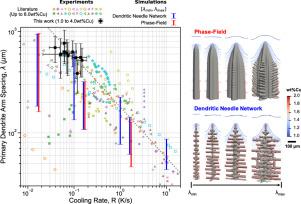Acta Materialia ( IF 8.3 ) Pub Date : 2021-01-22 , DOI: 10.1016/j.actamat.2021.116686 B. Bellon , A.K. Boukellal , T. Isensee , O.M. Wellborn , K.P. Trumble , M.J.M. Krane , M.S. Titus , D. Tourret , J. LLorca

|
Microstructural length scales, such as dendritic spacings in cast metallic alloys, play an essential role in the properties of structural components. Therefore, quantitative prediction of such length scales through simulations is important to design novel alloys and optimize processing conditions through integrated computational materials engineering (ICME). Thus far, quantitative comparisons between experiments and simulations of primary dendrite arms spacings (PDAS) selection in metallic alloys have been mainly limited to directional solidification of thin samples and quantitative phase-field simulations of dilute alloys. In this article, we combine casting experiments and quantitative simulations to present a novel multiscale modeling approach to predict local primary dendritic spacings in metallic alloys solidified in conditions relevant to industrial casting processes. To this end, primary dendritic spacings were measured in instrumented casting experiments in Al–Cu alloys containing 1 wt.% and 4 wt.% of Cu, and they were compared to spacing stability ranges and average spacings in dendritic arrays simulated using phase-field (PF) and dendritic needle network (DNN) models. It is first shown that PF and DNN lead to similar results for the Al-1 wt.%Cu alloy, using a dendrite tip selection constant calculated with PF in the DNN simulations. PF simulations cannot achieve quantitative predictions for the Al-4 wt.%Cu alloy because they are too computationally demanding due to the large separation of scale between tip radius and diffusion length, a characteristic feature of non-dilute alloys. Nevertheless, the results of DNN simulations for non-dilute Al–Cu alloys are in overall good agreement with our experimental results as well as with those of an extensive literature review. Simulations consistently suggest a widening of the PDAS stability range with a decrease of the temperature gradient as the microstructure goes from cellular-dendrites to well-developed hierarchical dendrites.
中文翻译:

金属合金铸件组织长度尺度的多尺度预测
微观结构的长度尺度,例如铸造金属合金中的树枝状间距,在结构部件的性能中起着至关重要的作用。因此,通过模拟对这种长度尺度进行定量预测对于设计新型合金和通过集成计算材料工程(ICME)优化加工条件非常重要。迄今为止,金属合金中初级枝晶臂间距(PDAS)选择的实验与模拟之间的定量比较主要限于薄样品的定向凝固和稀合金的定量相场模拟。在这篇文章中,我们结合铸造实验和定量模拟来提出一种新颖的多尺度建模方法,以预测在与工业铸造工艺相关的条件下凝固的金属合金中的局部主要枝晶间距。为此,在仪器铸造实验中,在含有1 wt。%和4 wt。%Cu的Al–Cu合金中测量了一次枝晶间距,并将它们与使用相场模拟的枝晶阵列中的间距稳定性范围和平均间距进行了比较。 (PF)和树突状针网络(DNN)模型。首先表明,在DNN模拟中使用PF计算得到的枝晶尖端选择常数,对于Al-1 wt。%Cu合金,PF和DNN得出相似的结果。PF模拟无法获得Al-4 wt。的定量预测。%Cu合金,因为由于尖端半径和扩散长度之间的氧化皮之间的比例较大而对计算量要求过高,这是非稀释合金的特征。尽管如此,非稀释Al-Cu合金的DNN模拟结果总体上与我们的实验结果以及广泛的文献综述相吻合。模拟始终表明,随着微观结构从蜂窝状树枝状晶体向发达的分层树枝状晶体发展,随着温度梯度的降低,PDAS稳定性范围不断扩大。非稀释Al-Cu合金的DNN模拟结果总体上与我们的实验结果以及广泛的文献综述相吻合。模拟始终表明,随着微观结构从蜂窝状树枝状晶体向发达的分层树枝状晶体发展,随着温度梯度的降低,PDAS稳定性范围不断扩大。非稀释Al-Cu合金的DNN模拟结果总体上与我们的实验结果以及广泛的文献综述相吻合。模拟始终表明,随着微观结构从蜂窝状树枝状晶体向发达的分层树枝状晶体发展,随着温度梯度的降低,PDAS稳定性范围不断扩大。










































 京公网安备 11010802027423号
京公网安备 11010802027423号